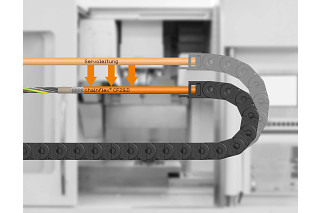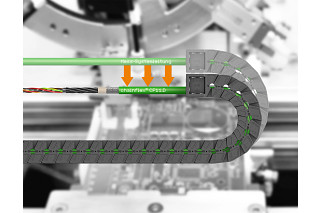Change Language :
chainflex® creates space!

Smaller radii, smaller machines...greater possibilities
In line with current trends, modern machines are becoming smaller and more compact, meaning that smaller radii are increasingly being used in energy chains. The challenge is then to use cables that can withstand this additional load. After all, they should still be able to work for a long time with high durability, safety and reliability. Standard cables cannot reliably fulfil these conditions. Which cables are suitable for small installation spaces? How can a long service life and safety be achieved? Answers to these questions and other useful information can be found here.
No more space for good cable routing in your machine?
In this video we explain in a clear way how we solve the space problem. See for yourself!
Reduce installation space by up to 25% – motor cables

A motor cable appears to be a comparatively simple cable. Its only task is to supply the motor with power. Due to the connection to a frequency converter, the voltage class is 600V/1000V and has four cores (L1, L2, L3, PE). Motor cables are used where a lot of energy has to be transmitted, but the requirements in automation technology have increased dramatically in recent years.
In order to fulfil all these requirements plus the continuous mechanical load in an energy chain, the materials and manufacturing processes used are the key to the function of motor cables. After all, ensuring a reliable power supply to the drive under high loads remains elementary. One example of this is the use on harbour cranes.
igus® motor cables are made with special high-quality cross-linked XLPE insulation materials. These materials, which are specially adapted to energy chain applications, offer the advantage of low capacitance coating for fast, low-loss switching times and very high temperature reserves of the insulation with higher current density. They must also have a high service life over long distances or when subjected to severe bending. In addition, the stranded wire in the core must be of very high quality in order to be able to move the cable permanently in small installation spaces. This ensures a long service life and reliable power supply.
You can find more information about chainflex® motor cables here.
Reduce installation space by up to 32% – servo cables

A servo cable, like a motor cable, supplies the motor with power. Here, too, we naturally utilise the advantages of XLPE core insulation. But it also has other crucial functions: It supplies the motor's brake with energy and/or transmits the signal from the temperature sensor to the frequency inverter. For this purpose, a servo cable has one or two additional control pairs that are additionally shielded so that no interference reaches the frequency inverter. Servo cables often also have an overall shield to prevent electronic magnetic interference, as they then have better electromagnetic compatibility specifications. Compared to motor cables, servo cables are therefore much more complex and have a much larger core. Due to the additional shielded control pairs, the cable is no longer as symmetrical as a motor cable, for example. This poses a particular challenge when designing a high-quality cable.
This is solved by the gusset-filling extruded inner jacket, which on the one hand provides a firm foundation for the screen and on the other hand wraps itself around the additionally screened control pair and guides the core in the longitudinal direction. The inner jacket is of particular importance here, as this is the only way to achieve a long service life for the core and guaranteed durability of the high-quality screen. Long travel distances and small bend radii also put even more strain on the cable, so that special protection must be provided. A typical application for a servo cable is a storage and retrieval unit, but it is also indispensable in machine tools or handling gantries.
You can find more information about chainflex® servo cables here.
Reduce installation space by up to 32% – measuring system cables

measuring system cables are often also called feedback or encoder cables. They are used for signal feedback from the encoder system to the frequency inverter. The high information density such as speed, angular position and other information that is important for the correct use of drives in automation technology is transmitted in the cable using different signal wire combinations. This means a colourful mixture of different cross section, number of cores and shield combinations. These combinations must be particularly protected during movement, which is realised using special pair shields or element jackets.
Long distances and small bend radii pose a particular challenge, as extreme forces act on the cable here. When manufacturing a measuring system cable, it is important to use particularly high-quality and selected materials due to the sensitive components in the cable. High-quality materials such as TPE, an extruded cast-filling and robust inner jacket throughout, a particularly tightly braided screen with high coverage and optimum braid angle are essential components that make the measuring system cable durable and fail-safe. They are particularly important because measuring system cables are used wherever movement takes place.
Here you can find more information about the chainflex® measuring system cable.
Specialist articles on the subject of materials
You can download much more detailed information free of charge here
Consulting
I look forward to answering your questions

Katharina Wielpütz+49 2203 9649 7082Write e-mail
Shipping and consultation
In person:
Monday to Friday from 7 am - 8 pm.
Saturdays from 8 am- 12 pm.
Online:
24h
WhatsApp-Service:
Montag – Freitag: 8 – 16 Uhr